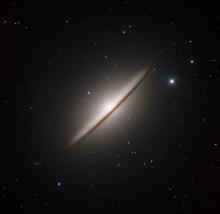Listen to today's episode of StarDate on the web the same day it airs in high-quality streaming audio without any extra ads or announcements. Choose a $8 one-month pass, or listen every day for a year for just $30.
You are here
Monoceros
A unicorn follows Orion across the sky: Monoceros, which is to the lower left of Orion at nightfall. It’s not much to look at, though — its brightest stars are so faint that you need pretty dark skies to pick them out.
Perhaps it’s fitting, then, that one of its most interesting denizens is a black hole — the closest one to Earth.
A0620-00 is more than 3,000 light-years away. The black hole produces no energy. But it has a companion — a “normal” star about half as massive as the Sun. And it’s the interactions between these two objects that reveals the black hole’s presence.
For one thing, over the last century or so, A0620 has flared up twice. The second of those events was observed by an X-ray telescope in space. It found that the system’s X-ray brightness jumped to a hundred thousand times its normal level.
The outbursts may have been produced by gas that the black hole “stole” from its companion. The black hole takes gas from the star all the time, forming a disk around the black hole. As the gas piles up, though, it may become unstable. Lots of gas may plunge toward the black hole in a rush, heating to millions of degrees and shining brightly just before it vanishes.
Measuring the orbit of the visible star and its dark companion suggests that the black hole is about six times the mass of the Sun — a small black hole that’s a fairly close neighbor.
More about Monoceros tomorrow.
Script by Damond Benningfield






